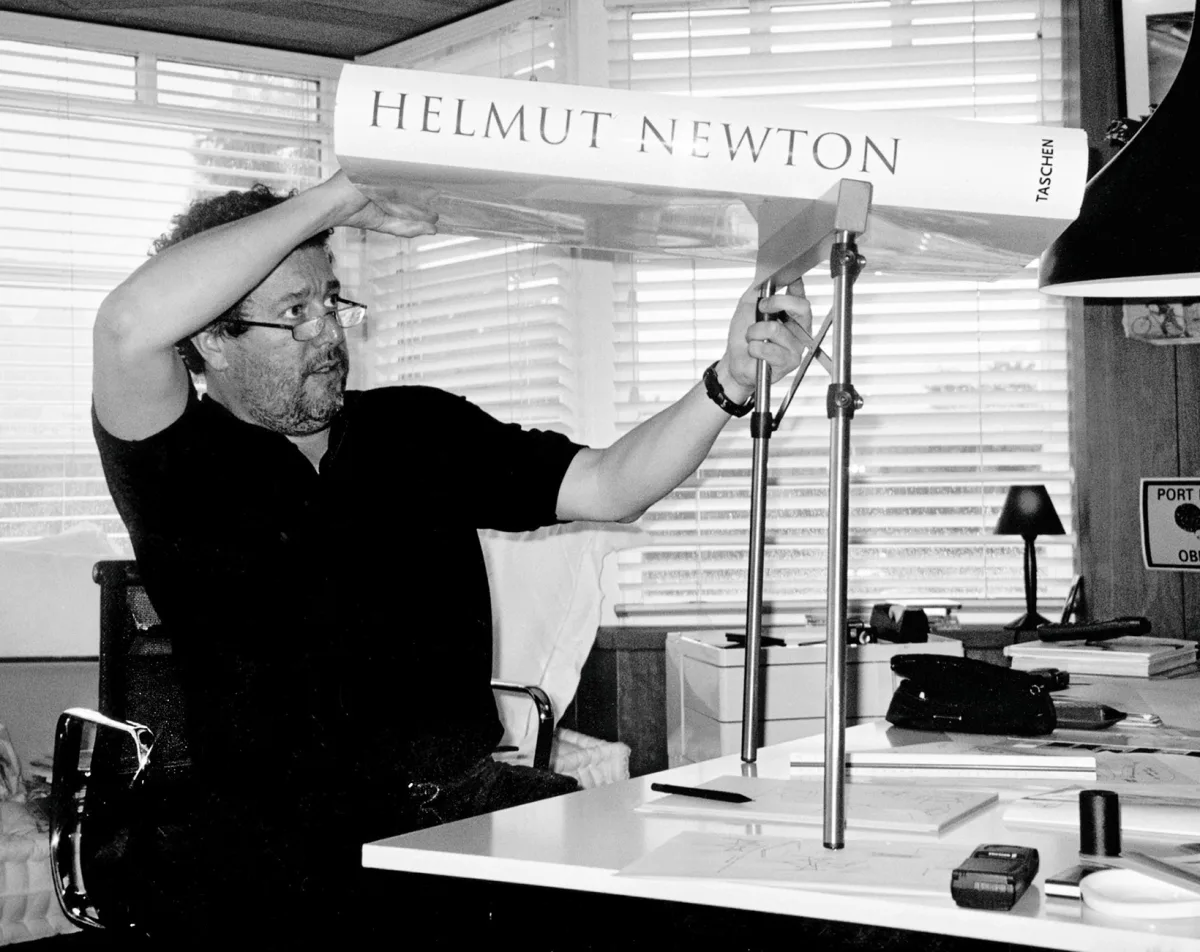Reach for the Essential
Philippe Starck on democratic designs and intelligent structures
Philippe Starck working on the design of the stainless steel SUMO table in his studio, Paris, 1998.
How did you meet Benedikt? How did your collaboration
with TASCHEN start?
I can’t remember how or when I met Benedikt Taschen,
because the meeting seems anecdotal and meaningless
compared to the person. Before everything, that person
was an extraordinary voice, a voice that raised the dead,
a voice from beyond the grave, a voice that made women
from all continents fall. The dream voice. A voice so deep
that sometimes we couldn’t hear, as there was only bass
and infrabass.
I didn’t want to make books. Actually, it’s been 12 years since our last book—it’s my fault I am unable to finish the one in progress, which shows my degree of urgency. I used to find coffee table books—these big, heavy, expensive art books—quite anti-democratic. For me, they were social representations that no one really browsed through, only displayed to show we have wealth, culture, and a sturdy coffee table (well designed by a famous creator) that can support them.
When I discovered by chance TASCHEN Editions, I also discovered that their prices were exactly in line with my work on democratic design. I thought that with these prices, TASCHEN books were actually like TV at that time: going everywhere, reaching everyone, with no social discrimination. That is the reason why, on the day we met, I signed with him.
He still is the only one I have signed with. It must be said that Benedikt is an incredibly special person and an incredibly loyal friend. When you’re friends with Benedikt, it’s for life. What I like about Benedikt is that he is a man of very few words. He listens. Each “non-answer” is a deep acquiescence: not out of courtesy or disinterest, he simply agrees. And we always agree.
What was the inspiration / impulse for the SUMO
bookstand?
I don’t precisely remember the inspiration that reigned
over the creation of the SUMO bookstand. But when I
see it now, I understand that I wanted to create a useful
object that would show an extremely intelligent foldable
structure. That, I didn’t design; I am not that clever. It is
a structure that already existed among ancient Egyptians.
It is without doubt the most intelligent foldable structure
ever made. I was not interested in creating a beautiful
object, but in showing this intelligence.
What was the design process?
The design process is always the same: reach for the
essential
with the minimum of energy, the minimum of
matter, and try to prove more than the simple function
of the object.
How did you approach the BABY SUMO edition?
I can only like the new BABY SUMO because it connects
with my obsession with democratic design, democratic
production: being smaller, I suppose, it will cost less. All
that is beautiful and less expensive is a mark of respect to
people who don’t want to or can’t spend their money on
an object that is great yet secondary to survival.
Besides your very own book and the design of the bookstand,
you created the architecture for the first TASCHEN stores
(Paris 2000, Miami, Beverly Hills, New York, London...).
The first store, in Paris, took a radical new approach to
presenting books; what was your idea?
My idea was extremely simple: TASCHEN books are not
expensive but accessible to all, from all social classes.
Thus, paradoxically, I wanted the time of purchase to
feel like a privileged, exceptional moment. I wanted the
boutiques to be artistic, even luxurious. I couldn’t stand
the idea of selling these wonderful books on plywood
panels. I wanted to subconsciously give an added value
to the purchase of these books, especially since they are
almost always gifts.
How do you describe the collaboration with Benedikt?
My collaboration with B is that of old friends. Even if
we don’t see each other often, we have always shared the
same thought form: the best for everyone with a touch
of folly, excess, poetry, fantasy and above all an enormous
and permanent laughter. When B laughs, which
happens rarely but deeply, window glass splinters and
foundations tremble.
Your book with TASCHEN was a huge success. What did
it mean to you? Did the book reveal / illustrate anything
new about your work?
I didn’t know my book with TASCHEN was an important
success. I am very happy about it because I spend 10 hours
per day creating Christmas gifts for everyone, and I am
pleased when gifts are appreciated.
My books are not meant to show how handsome I am (that
would be a failure); to show how talented I am (that would
also be a failure); to show how genius I am (that, I am definitely
not). They are meant to show that the sky isn’t the
limit; that imagination is the greatest power; that we have
the duty to invent always with the highest vision, rigor, and
honesty; that everyone can do it, as creativity isn’t genetic
or of divine order but it is a will, a choice of life: to dedicate
one’s life, to only exist to the benefit of the dream.
What does TASCHEN mean to you? What does TASCHEN
stand for?
TASCHEN is a fantastic educational tool. Almost everyone
can have access to almost every existing form of culture.
With such editorial quality, TASCHEN should be reimbursed
by the Social Security.
What’s your favorite TASCHEN book?
All of them, as each complements the others. Each book
gives a facet of humanity, so they’re all interesting to me.

